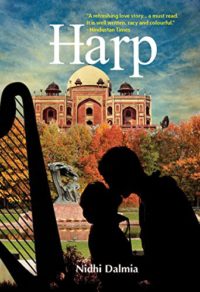Title: Harp
Author: Nidhi Dalmia
Publishing: Book-Art Press Solutions
ISBN: 978-9384439798
Pages: 418
Genre: Romance
Reviewed by: Lisa Brown- Gilbert
Hollywood Book Review
Nidhi Dalmia’s premiere work, Harp courts readers with a multifaceted and earnestly romantic narrative. The story follows the lives of several prominent characters during the late 1960s, as they forge their personal paths to adulthood via their life experiences with love, desires, and acceptance, leading each ultimately to some level of self-discovery.
Growing up protected and part of the Indian middle class, siblings, Ashok, Neeru, and Gita, all look to find their way in the world during the late 1960s in India, a time when miniskirts and the sexual revolution was a prevailing aspect of life. Primarily, the story focuses on Ashok and two love interests, exposing his experiences with responsibility, romance, and acceptance, however, there are also brief interludes focusing on the movements and experiences of Ashok’s sisters; Gita, his younger sister, and Neeru his older sister.
Immediately, this character driven story introduces Ashok, a strong-willed and fairly attractive young man, whose freedom, determination and desires lead him to many opportunities and life experiences. The tone of the narrative is set by an intimate encounter between Ashok and girlfriend Nalini before she leaves for boarding school. He is presented as a seemingly healthy young man, curious, sexual but also somewhat unsure of himself. Both the interaction and passion of this intimate encounter seems to set the tone of the narrative thusly portraying that relationships and sexuality will play a big role in Ashok’s maturation and life’s journey.
Meanwhile after graduating school Ashok, acts on his desire to enhance his skills for the family business, a dairy products factory, by seeking training in Europe, a feat accomplished by receiving multiple scholarships, which sends him traveling to some lesser known, but well detailed locales of Europe, which in turn, also catalyzes his path to self-discovery as he encounters the varied cultures, food, and social settings while enmeshing himself culturally and making acquaintances with friends, lovers, and potential lovers.
Eventually, Ashok becomes entwined in two impassioned relationships which have the most profound effects on his life. First, there was Lauren a Polish-born Harp player, their passions left indelible marks on each other’s hearts, albeit, the cultural divide and other elements seemed to get in the way. On the other hand, there was Aparna who had grown up in India and who was more like Ashok culturally. Besieged by tough decisions, sacrifices and business struggles Ashok like the other characters faces the path of his life directed, by decisions and their subsequent consequences.
Altogether, Harp turned out to be a very interesting read that garnered my attention by incorporating the varied elements of romance, sex, and travel, as well as detailed observations of the cultural, political, and social climates of many lesser-known European locales, during the late 1960s. An included necessity of the book is a glossary of foreign words and phrases as the author often uses vernacular from many different cultures. Overall, this book would make a worthwhile read for fans of romance and travel.

